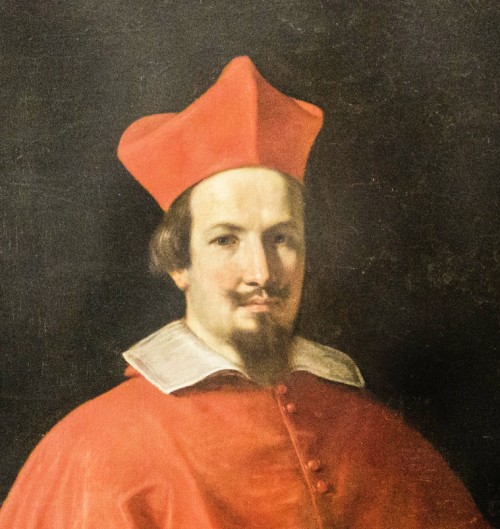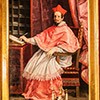Cardinal Bernardino Spada (1594–1661) – a dream about the grandeur of his own family

Portrait of Cardinal Bernardino Spada, fragment, Guido Reni, Galleria Spada

Portrait of Cardinal Bernardino Spada, Guercino, Galleria Spada

Perspective gallery, Palazzo Spada

Portrait of Cardinal Bernardino Spada, Guido Reni, Galleria Spada

Chapel of the Spada family, church of San Girolamo della Carità

Chapel of the Spada family, church of San Girolamo della Carità

Palace of Cardinal Bernardino Spada - Palazzo Spada

Portrait of Cardinal Bernardino Spada, fragment, Guercino, Galleria Spada
Cardinal Spada was a sensible and trustworthy man – diligent and intelligent, he climbed the ladder of a Church career slowly and reasonably. He had great ambitions, although ultimately he was unable to sit upon the papal throne. But he never stopped thinking about it and all his actions, focused on bringing his insignificant in the Eternal City family into the ranks of the black aristocracy, served this purpose. Who was then, this diligent and private official with extraordinary ambitions?
Cardinal Spada was a sensible and trustworthy man – diligent and intelligent, he climbed the ladder of a Church career slowly and reasonably. He had great ambitions, although ultimately he was unable to sit upon the papal throne. But he never stopped thinking about it and all his actions, focused on bringing his insignificant in the Eternal City family into the ranks of the black aristocracy, served this purpose. Who was then, this diligent and private official with extraordinary ambitions?
The Venetian ambassador residing in Rome wrote that Cardinal Spada was of humble origins, while his ancestors were farm workers and charcoal burners. This opinion was most likely unjust and not quite truthful, but it became the most painful scar on the heart of the clergyman who had wanted to wipe this stain clean for the rest of his life. That which hurt him so dearly, was also what brought him luck since he never suffered for lack of money. He took advantage of the fortune amassed by his father Paolo Spada – an entrepreneur who was a member of the petty nobility, and who dealt in coal. He raised his offspring in discipline, favoring Bernardino who seemed most likely to succeed out of all his children. He spared no money for his education and career. Bernardino studied literature and law in Rome and after being ordained he joined the ranks of the administration of the State of the Church. He worked for popes Paul V and Gregory XV, but a true breakthrough in his career turned out to be meeting Cardinal Maffeo Barberini – the future Pope Urban VIII. They both shared a passion for making rhyming poems in classic Latin. Cardinal Spada devoted all his life to it. His love for poetry can be testified to by the fact that for many years he was the patron of the poetess Marta Marchini, whose works along with several poems written by the cardinal himself were published a year after his death thanks to his brother Virgilio.

The election of Barberini as pope (1623) was for the Spada family as a flight towards the stars. The results were not long in coming. At the age of twenty-nine, Bernardino received the prestigious proposal to take over the nunciature, meaning the diplomatic representation of the State of the Church at the French court in Paris and then the office of the pope's legate in Bologna. In holding the latter of the aforementioned posts he exhibited sensibility, foresight, and great organizational skills. The residents of the city (which belonged to the State of the Church) remembered him as a manager who used his private funds and improved the standard of living of all the residents of Bologna who at that time experienced hunger, epidemics, and war. He lowered the prices of bread, built a hospital, and was heavily involved in combating banditry which was running rampant in the city at the time. After his time in office was concluded he came back to Rome in 1631 receiving numerous responsible functions in the papal Curia. He also became famous for putting an end to an attack on Rome by the Farneses, by conducting a peace mission in 1632 in Parma. In time he gained the position of one of the most important and respected members of the Roman Curia and he maintained it even after the death of Urban VIII.
After settling in Rome for the next thirty years the thoughts of Cardinal Spada besides Church matters, which he was very enthusiastic about, revolved around his family, whom he tried to ennoble in every possible way. One of these methods was beneficial marriages. This strategy was put into effect by his nephew Orazio Spada who married into the outstanding Roman Veralli family and boasted numerous children.

The cardinal lived along with his nephew, his wife Maria Veralli-Spada, and their eleven children in an elegant palace that he himself bought (Palazzo Spada) and devoted himself to modernizing its interior. He entrusted this task to Francesco Borromini, among others, who created the famous forced perspective optical illusion. He also amassed a great collection of works of art, which at the time served as a manifestation of high social status. and to a lesser degree showed actual interests of the cardinal. Nevertheless, this collection, which still exists today in the palace (Galleria Spada), is one of the most interesting in the Eternal City. It contains outstanding works of art by great artists from the Baroque and not only. The responsibilities of pater familias also included leaving family portraits – the evidence of their own prestige. He ordered several of these – from among the most outstanding painters of the time – Guido Reni (Portrait of Cardinal Bernardino Spada) and Guercino. The next step in elevating the family was paying tribute to the family ancestors, who were brought out from the obscurity of ages past to prove the family's longevity. In this way, the Spada Chapel was created in the Church San Girolamo della Carità. With this gesture, the cardinal and his brother Virgilio who aided him with this task wanted to erase being seen in the city as upstarts with no proper family history. Which ancestors could be seen in the chapel – a medieval papal official, a rather unknown Bishop Bernardino Lorenzo Spada, and the images of mythical ancestors who proudly bore the surname of Spada (epee in English). The initiator of the concept and decoration of the chapel was Virgilio Spada – an Oratorian and at the same time a talented amateur artist.

Why did the responsible, diligent, and devoted to the Church and the State of the Church Cardinal Bernardino Spada not become pope? Certainly, there were opportunities, but his candidacy was never seriously considered. Most likely it was his inability to gain supporters, commanding respect rather than positive feelings, but the greatest obstacle was his large family and the sheer number of nephews. After the death of Urban VIII and the nearly twenty-year-long era of the papacy of the Barberini family, nepotism was looked upon with greater and greater distrust in the State of the Church. It was not so much the immoral implications of such a phenomenon but more a question of sensibility. People feared another family, that would (similarly to the Barberinis) bring together all the power, wealth, and Church finances under the wings of ambitious but above all numerous relatives. Nevertheless, these nephews were the pride and joy of the Spada family and presented an opportunity to elevate the unknown-in-Rome family to the same status as that enjoyed by such families as Barberini, Pamphilj, or Giustiniani.
As it would seem, the prematurely deceased cardinal right until the end believed that he would become a pope, while his chances in this regard are confirmed by the letters exchanged by ambassadors and cardinals of those times. After an illness that lasted nearly fifty days, and which manifested itself with a fever, weakness, and chills, the cardinal died surrounded by his family at the age of sixty-seven, most likely due to stomach cancer.

After his death, Virgilio wrote his biography, in which it could clearly be seen that Bernardino was shown in a very favorable light – a flawless papal official and a consummate diplomat. In the biography, the cardinal was presented as a serious, almost harsh individual, closed off, hard-working, and responsible, one who was not fond of any form of entertainment enjoyed by the upper classes (hunting, theatre, balls), yet he himself readily organized luxurious feasts. It seems that Bernardino Spada devoted all his time either to writing or to reading, and generally rarely left his study. The biographer even talks of an anecdote in which one of the sons of his nephew Orazio, when asked whom he would like to be in the future – “a knight, a monk, or a cardinal”, answers that definitely not a cardinal since he does nothing but sit at a desk and write.
The greatness of a man is measured by the buildings he leaves behind and the marriages he arranges – this was the motto of Bernardino, and in this regard, he was a man of his time period. He fulfilled these tasks in an outstanding fashion, especially when it comes to the former, which we can see wandering around in Rome, visiting the buildings he left behind, and admiring his art collection.





















